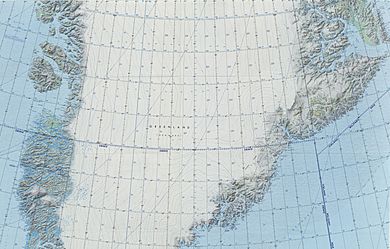British Arctic Air Route Expedition facts for kids
The British Arctic Air Route Expedition (BAARE) was an exciting adventure to the east coast and inside of Greenland. This trip happened from 1930 to 1931. It was led by a brave explorer named Gino Watkins. The main goals were to make better maps of Greenland's coast, which wasn't well known then. They also wanted to collect weather information from the coast and the icy interior during the cold Arctic winter. This big trip was followed by a smaller one in 1932–1933, also led by Watkins until he sadly passed away.
Contents
What Was the British Arctic Air Route Expedition?
The British Arctic Air Route Expedition was a private journey. This means it was paid for by people and groups, not by the government. The team traveled to Greenland on a famous ship called the Quest. This ship had been used before by another famous explorer, Ernest Shackleton, in 1921–1922.
Who Was on the Expedition Team?
Many skilled people joined the expedition. They included explorers, scientists, and pilots. Some key members were Freddie Spencer Chapman, John Rymill, and Augustine Courtauld. There was also a meteorologist (weather scientist) named Quintin Riley. Lawrence Wager was the geologist, who studied rocks and the Earth. Alfred Stephenson was the chief surveyor, in charge of mapping. Pilots like Narbrough Hughes D'Aeth and Wilfred Hampton helped with flying. A doctor, Edward W. Bingham, and a photographer, Iliffe Cozens, were also part of the team.
Where Did They Set Up Camp?
When the team arrived in Greenland, they built their main camp. They called it the base hut. This winter camp was on a fjord coastline. It was about 30 miles (48 km) west of a town called Tasiilaq. Most of the team stayed here for the winter. They also met and learned from the local Inuit people. From this base, they sent out smaller groups to map and explore nearby coastal areas.
Exploring the Icecap Station
The expedition also collected important weather data. They did this at the base camp and at a special outpost called Icecap Station. This station was built right on top of the huge Greenland ice cap. It was very high up, about 8,600 feet (2,621 meters) above sea level. It was also far away, about 112 miles (180 km) west of their main base camp.
Who Stayed Alone at Icecap Station?
One member, Augustine Courtauld, bravely volunteered to stay alone at Icecap Station. He spent five months there by himself during the coldest part of the 1930–1931 winter. He collected weather information all that time. Gino Watkins and other team members finally reached him on May 5, 1931. They arrived just as Courtauld was running out of food and fuel. His observations were some of the first long-term weather records ever taken from the middle of the Greenland ice cap during a polar winter.
What Happened at the End of the Expedition?
After their amazing journey, the expedition members, including Watkins and Courtauld, went back home. They first stopped in Denmark and then returned to England. They were celebrated and praised in both countries for their bravery and discoveries. Key members of the expedition were given the Polar Medal by King George V. This was a very special award. It was the first time this medal had been given for Arctic service in 60 years!
See also
- Cartographic expeditions to Greenland
- Schweizerland
- Watkins Range


